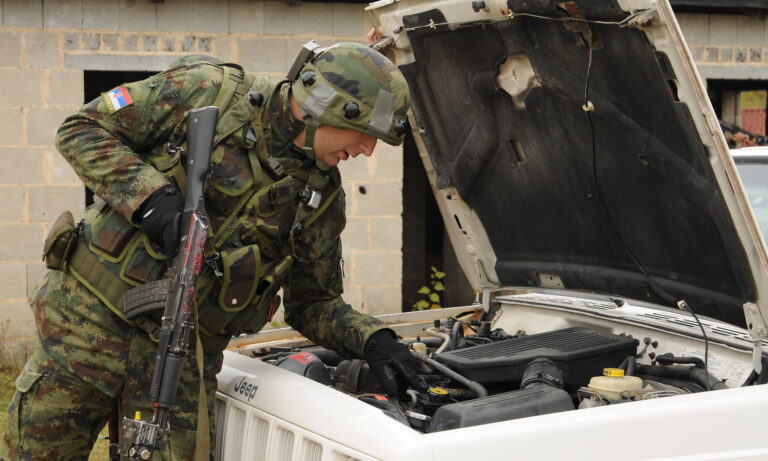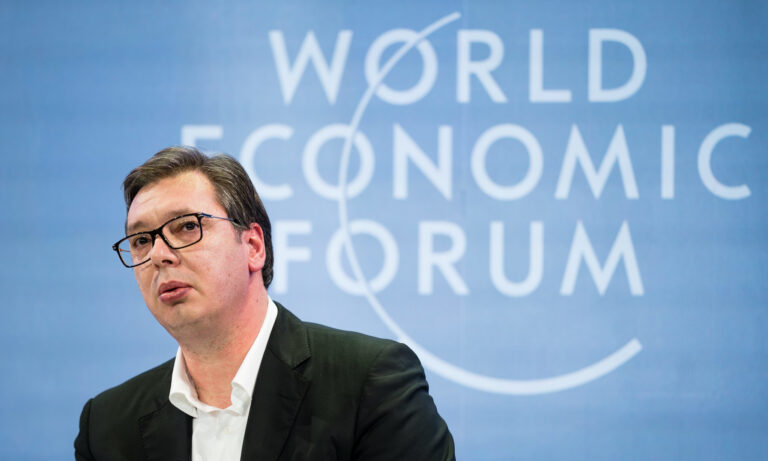
This article was originally published in The Diplomat and is republished here with the permission of the author.
When a plane carrying a million doses of COVID-19 vaccines from the Chinese company Sinopharm landed at Belgrade airport on January 16, many interpreted the moment as a continuation of China’s “mask diplomacy” that could now be called “vaccine diplomacy.” The formal reception at the highest level, hosted by Serbian officials led by President Aleksandar Vucic, has once again confirmed that China’s efforts to position itself as Serbia’s most important partner in the fight against the COVID-19 pandemic have been accepted and effective.
The arrival of the plane with vaccines from China is just another step in the cooperation between Serbia and China in an attempt to mitigate the consequences of the COVID-19 pandemic. In March 2020, after Vucic stated that “European solidarity does not exist“ and that “only China can help Serbia fight the virus,” the first shipment of protective medical equipment from China was ceremoniously welcomed with copious praise for the friendship and cooperation between Belgrade and Beijing, as well as the role of Chinese leader Xi Jinping. Chinese medical workers, who were in Serbia in the early stages of the pandemic, and “Fire Eye“ laboratories, which were built and opened in several locations in Serbia, have strengthened China’s position as an actor unreservedly committed to helping Serbia fight the virus.
And while Serbian officials praised the role of China, the European Union (EU) has been pushed into the background. Although the EU is the largest trading partner and investor in Serbia, and despite the fact that donations to improve the health system have come from the European Union for many years, except on rare occasions, Serbian officials have not emphasized cooperation with Brussels in a way they did with China. Once again, Serbia was between the West and the East. While Serbia’s membership in the EU remains a proclaimed foreign policy objective, cooperation with partners from the East is being actively pursued and improved.
For Serbia, another moment of divisiveness between East and West comes at a time when the world enters the first phase of mass immunization. The choice of vaccine manufacturer for Serbia is not only a matter of combating the pandemic, but also a matter of foreign policy. Serbia, along with other Western Balkan countries, has been promised to be part of the Covax system, with the help of the European Union, but mass vaccination in Serbia has begun even before the system has produced its first results.
At the very end of 2020 and the beginning of January 2021, slightly more than 10,000 doses of the Pfizer vaccine arrived in Serbia. The vaccines from the German/American manufacturers, according to reports, arrived as a result of the efforts of Serbian officials, and not as a consequence of cooperation with the EU through the Covax system. Serbian Prime Minister Ana Brnabic was among the first Serbian officials to receive the Pfizer vaccine. However, the small contingent (slightly more than 11,000 doses of vaccines from this manufacturer arrived in Serbia) left open the question of how Serbia would provide for mass immunization. Or to be more precise, who will be the main supplier. In addition to Pfizer, there were announcements that a contingent of Sputnik V vaccines from Russian, vaccines manufactured by the British-Swedish firm AstraZeneca, and Chinese Sinopharm vaccines will arrive in Serbia.
The answer arrived in mid-January, along with a million Chinese vaccines. While this time there was no kissing of the Chinese flag, Vucic once again celebrated the good relations between Serbia and China during the reception. Vucic also used the opportunity to point out that Serbia had not received any vaccine through the Covax system, although it had paid upfront for inclusion in the program. Accompanied by the Chinese ambassador, Chen Bo, Vucic said that the fact that Serbia procured or will procure vaccines from four different manufacturers is “proof of the ability of the domestic political leadership,” and that Serbia does not hide that it has good relations with China. The president of Serbia also expressed his affection and gratitude to the Chinese partners by announcing that he will receive the vaccine from the Chinese manufacturer. At the time when the Sinopharm vaccines arrived in Serbia, the shot did not have approval from the Medicines and Medical Devices Agency in Serbia; the permit was obtained a few days after the contingent arrived.
In addition to the citizens of Serbia, Chinese workers employed in Serbia will be vaccinated with the Chinese vaccine as well. In the last five years, Chinese workers have been employed in the construction of infrastructure projects that Chinese companies are implementing in Serbia, with the help of loans that the state of Serbia took from Chinese banks. Also, Chinese workers are employed in the copper mines in Bor, the steel mill in Smederevo, and the vehicle tire factory in Zrenjanin. All these factories are a result of Chinese foreign direct investments in Serbia since 2016.
How Serbian officials, led by Vucic, talk about Chinese vaccines, as well as the fact that the EU has not proven to be an effective partner in the process of procuring vaccines, largely reflects Serbia’s foreign policy. The vaccines that should have arrived from (and with the support of) the EU did not arrive and there are no clear indications when they will be available to Serbian citizens. Meanwhile, vaccines produced by Chinese companies arrived in Serbia quickly and in large quantities. The suspicion that people who receive the Chinese vaccine will not be able to travel freely to EU countries did not discourage Serbian citizens from getting the shot – within a week after the first administration of the Chinese vaccine, more than 200,000 people received the vaccine.
The EU, once again, remained in the shadow of China, Serbia’s “steel friend,” when it comes to the fight against the COVID-19 pandemic. At a time when Serbian officials are promoting the Chinese vaccine and once again praising cooperation with China, the EU is not providing visible help but instead offering repeated criticism of the Sino-Serbian friendship. A group of 26 members of the European Union parliament officially addressed the European Commissioner for Enlargement and Neighborhood Policy and expressed concern over the increased Chinese influence in Serbia. While the problems pointed out by MEPs (primarily the harmful impact of Chinese factories on the environment in Serbia) are legitimate, the timing of the expressed concerns can be interpreted as unfortunate. It happened at the moment when Serbian officials were promoting the vaccine from China, once again giving the impression of the EU as an actor that provides criticism while help is lacking.
Even while anticipating help from the EU and the new contingent of vaccine producers from the West, Serbia once again embraced help from the East. In this way, the country’s readiness to cooperate with all relevant actors was confirmed. The question of whether Chinese vaccines are the first choice or the best alternative, at a time when the main goal of the authorities in Serbia is to carry out mass immunization, remains in the background. The slowness of the Covax system, the lack of supply by the Western manufacturers, and the relatively high level of availability of the Sinopharm vaccine have all made the Chinese vaccine the only choice for Serbia. It remains to be seen whether the slowness of the EU system, the opportunistic nature of the regime in Serbia, and Beijing’s willingness to meet the needs of Belgrade will affect some other processes involving these actors: for example, the European integration process and Serbia’s EU membership prospects.
Written by
Stefan Vladisavljev
vladisavljev_sStefan Vladisavljev is CHOICE Visiting Fellow. He is also the Program Coordinator of the Serbia-based non-governmental organization Foundation BFPE for a Responsible Society. He analyzes Chinese presence in Central and Eastern Europe with a special focus on Serbia and the Western Balkans.


